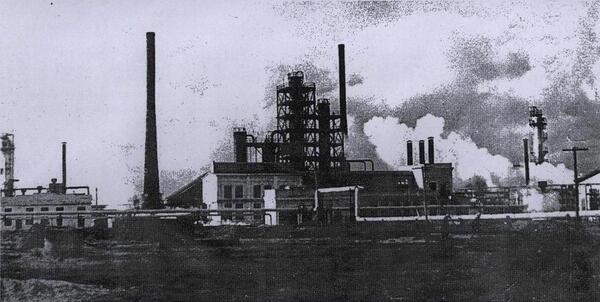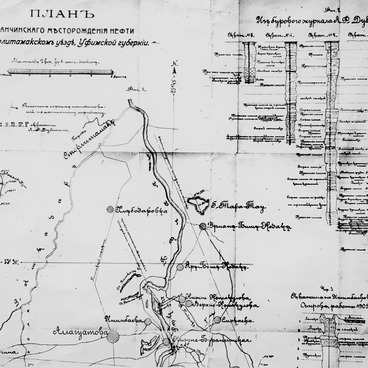This photograph depicts the Ishimbay Oil Refinery. Its history began with Decree No. 350 of the People’s Commissariat of Heavy Industry of the Soviet Union dated October 1, 1934, which commanded the Vostokneft trust company ’…to immediately begin the installation of a gasoline extraction unit in Ishimbaevo.’ As soon as May 31, 1935, the project by Nefteproekt’s engineers SmUrov and MonAkov was approved by the Chief Directorate of the Oil Industry. The project proposed the construction of not just a gasoline extraction unit but a large refinery.
The construction, which began almost immediately, was headed by Ivan Novikov, who went on to become the refinery’s first director. With the help of construction workers and specialists who came here from all over the country, the refinery was completed by late August 1935, its construction taking less than a year. A large number of companies based in different parts of the Soviet Union contributed to the construction: the treater vessel and heat transfer units were manufactured in the town of Podolsk near Moscow, boilers were provided by Kiev’s Lenkuznitsa factory, pumps came from the Krasny Molot factory in Grozny, motors were supplied by St. Petersburg’s Electrosila, and pipes were produced by the Taganrog and Dnepropetrovsk factories. The Ufa Mining Equipment Plant and the Sterlitamak-based Metallist carried out metal casting works and the manufacturing of flanges, which are a type of flat joints. The construction project also received invaluable assistance from the collective and state farms of Bashkortostan.
By October 17, 1936, the Ishimbay Oil Refinery had already reached its design capacity. On November 23 of that year, a train carrying 18 tank cars of Ishimbay gasoline arrived in Moscow as a tribute to the 8th Congress of Soviets, and on December 20, the refinery was approved by the government commission. Subsequently, it became part of Ishimbay’s massive oil refinery network: by 1939, the construction of a gasoline plant already began on the left bank of the Belaya River, and on July 31, 1941, the Council of People’s Commissars made a decision to build a lampblack factory in Ishimbay.
Furthermore, during the Great Patriotic War, this network was expanded with the Neftegaz-8 plant, as well as pyrolysis and sulfur factories: the vast scale of the construction of refineries is evidenced by the fact that several major trust companies were at once engaged in these projects. During the war, all factories produced goods to help the war effort. By the end of 1989, Ishimbay’s oil refining operations were put to a halt. This is how the 53-year history of the Ishimbay Oil Refinery came to a close. Over the years of its existence, the refinery processed 200 million metric tons of oil, produced huge amounts of oil products, significantly contributed to the city’s development, and aided the construction of one of the country’s best Palaces of Culture.
The construction, which began almost immediately, was headed by Ivan Novikov, who went on to become the refinery’s first director. With the help of construction workers and specialists who came here from all over the country, the refinery was completed by late August 1935, its construction taking less than a year. A large number of companies based in different parts of the Soviet Union contributed to the construction: the treater vessel and heat transfer units were manufactured in the town of Podolsk near Moscow, boilers were provided by Kiev’s Lenkuznitsa factory, pumps came from the Krasny Molot factory in Grozny, motors were supplied by St. Petersburg’s Electrosila, and pipes were produced by the Taganrog and Dnepropetrovsk factories. The Ufa Mining Equipment Plant and the Sterlitamak-based Metallist carried out metal casting works and the manufacturing of flanges, which are a type of flat joints. The construction project also received invaluable assistance from the collective and state farms of Bashkortostan.
By October 17, 1936, the Ishimbay Oil Refinery had already reached its design capacity. On November 23 of that year, a train carrying 18 tank cars of Ishimbay gasoline arrived in Moscow as a tribute to the 8th Congress of Soviets, and on December 20, the refinery was approved by the government commission. Subsequently, it became part of Ishimbay’s massive oil refinery network: by 1939, the construction of a gasoline plant already began on the left bank of the Belaya River, and on July 31, 1941, the Council of People’s Commissars made a decision to build a lampblack factory in Ishimbay.
Furthermore, during the Great Patriotic War, this network was expanded with the Neftegaz-8 plant, as well as pyrolysis and sulfur factories: the vast scale of the construction of refineries is evidenced by the fact that several major trust companies were at once engaged in these projects. During the war, all factories produced goods to help the war effort. By the end of 1989, Ishimbay’s oil refining operations were put to a halt. This is how the 53-year history of the Ishimbay Oil Refinery came to a close. Over the years of its existence, the refinery processed 200 million metric tons of oil, produced huge amounts of oil products, significantly contributed to the city’s development, and aided the construction of one of the country’s best Palaces of Culture.



